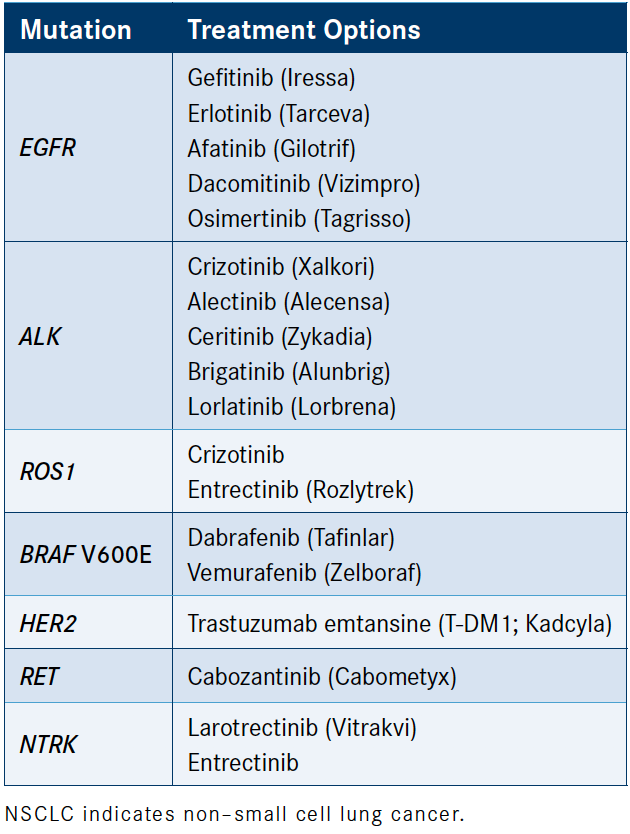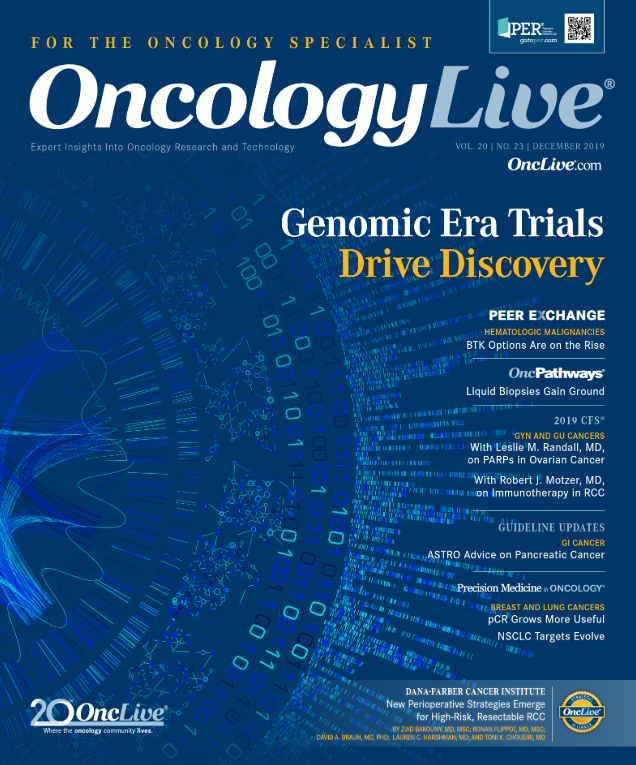Targeted Therapies Continue to Evolve in Metastatic NSCLC
The proliferation of targeted therapies in non–small cell lung cancer has helped improve overall survival for patients with metastatic disease and illustrates the importance of molecular testing,
Kathryn C. Arbour, MD

Kathryn C. Arbour, MD
The proliferation of targeted therapies in non—small cell lung cancer (NSCLC) has helped improve overall survival (OS) for patients with metastatic disease and illustrates the importance of molecular testing, according to a recent analysis published in JAMA.
Relevant mutations are found in approximately 30% of patients; these include EGFR and BRAF V600 mutations as well as ALK and ROS1 rearrangements.
Investigators examined data from a collection of clinical trials conducted between Janary 1, 2013 and May 1, 2019, that included randomized and nonrandomized trials to define important takeaways on the role of molecular testing, as well as the effectiveness of various targeted therapies, changes in standard treatments or regulatory approvals in NSCLC, and treatment guidelines.
“Treatment goals have evolved to [prevent] the development of resistance to targeted therapy,” the study authors wrote. “Long-term durable responses remain uncommon for most patients. The goal of NSCLC research is to understand and address mechanisms of resistant and refractory disease in patients with advanced disease and, ultimately, to increase cure rates.”
Molecular Testing
“Testing, such as hybridization capture—based next-generation sequencing platforms, allows oncologists to obtain comprehensive molecular test results with 1 assay,” authors Kathryn C. Arbour, MD, and Gregory J. Riely, MD, PhD, noted in the published report. “These approaches may be more cost-effective and reduce waiting time for patients compared with single-gene assays.”
Plasma circulating tumor DNA (ctDNA) is also an emerging option for identifying alterations in patients with insufficient tissue. Plasma ctDNA has a detection rate of >75% and a concordance rate of >95%, depending on the platform used, but clinicians can obtain results from these tests much faster than with a tissue biopsy. However, although additional testing is not necessary if ctDNA is positive, 20% of patients with negative ctDNA have molecular alterations that affect response to treatment.
“A combination of plasma testing and tissue testing may provide the greatest sensitivity for identifying molecular alterations responsive to treatment,” wrote the study authors. “Although plasma testing has demonstrated unique value in patients for whom tumor tissue is not available, the standard of care consists of testing tumor tissue, and this should be performed for all patients with metastatic NSCLC when feasible.”
The authors also emphasized the importance of testing PD-L1 tumor proportion score through immunohistochemistry assays as a biomarker for potential response to immune checkpoint inhibitors.
Approved Targeted Treatments
Combinations of platinum-based chemotherapies have demonstrated a reduced symptom burden and an improvement in quality of life and OS in patients with metastatic NSCLC compared with single-agent chemotherapy. Cytotoxic chemotherapy regimens also provide benefit in patients with a limited ECOG performance status, but these agents are generally associated with significant toxicities. Recent research has focused on the development of targeted therapies for patients whose tumors have targetable mutations (Table).
Approximately 20% of patients with NSCLC present with an EGFR mutation, most commonly L858R mutations or exon 19 deletions. Treatment options for these patients include EGFR tyrosine kinase inhibitors (TKIs), including first-generation gefitinib (Iressa) and erlotinib (Tarceva) and second-generation afatinib (Gilotrif) and dacomitinib (Vizimpro). However, approximately 60% of patients experience treatment resistance with these agents in the form of an acquired EGFR T790M mutation.
Osimertinib (Tagrisso), a third-generation EGFR TKI, has demonstrated the ability to overcome this resistance and induce tumor responses. Results of a randomized clinical trial showed that up-front osimertinib led to a PFS of 18.9 months as initial treatment compared with 10.2 months for patients who initially received a first- or second-generation TKI (HR, 0.46; 95% CI, 0.37-0.57; P <.001). Investigators noted a similar benefit in PFS with initial osimertinib treatment in patients with central nervous system metastases.
About 5% of patients with metastatic NSCLC have overexpression of the ALK protein. Crizotinib (Xalkori), which targets both MET and ALK receptor tyrosine kinases, was the first TKI to achieve tumor responses in this patient population. Newer and more potent ALK TKIs, such as alectinib (Alecensa), ceritinib (Zykadia), and brigatinib (Alunbrig), have proved effective in treating patients with resistance to crizotinib in early-phase clinical trials.
Next-generation ALK TKI alectinib demonstrated superiority to crizotinib in a randomized phase III trial of patients with metastatic ALK-positive NSCLC. The median PFS in patients who received alectinib was 34.8 months versus 10.9 months in those who received crizotinib (HR, 0.47; 95% CI, 0.34-0.65; P <.001).
In 2018, lorlatinib (Lorbrena), a third-generation ALK inhibitor, was approved for the treatment of patients with ALK-positive NSCLC and progressive disease following treatment with at least 2 prior ALK TKIs, based on data from a phase II multicohort trial.
Approximately 1% of patients with NSCLC have ROS1 rearrangements. Because ROS1 and ALK have similar homologies, ALK TKIs have been effective in the treatment of patients with these mutations. Specifically, crizotinib led to a 72% response rate in patients with ROS1- rearranged NSCLC and a median PFS of 19 months. Crizotinib is FDA approved in this setting, and in August 2019l, the FDA approved entrectinib (Rozlytrek) with a dual indication for patients with solid tumors, including NSCLC, with an NTRK gene fusion and for ROS1-positive NSCLC.
BRAF V600E mutations are present in 1% to 2% of patients with lung adenocarcinoma. BRAF inhibitors dabrafenib (Tafinlar) and vemurafenib (Zelboraf) have yielded short responses as single agents in this patient population, but results from a phase II clinical trial showed that the combination of a BRAF inhibitor and a MEK inhibitor, such as trametinib (Mekinist), induced a response rate of 64% with a median PFS of 11 months.
Emerging Targets and Treatments
Approximately 4% of patients with NSCLC have a MET exon 14 skipping mutation; crizotinib demonstrated a decrease in tumor size and a radiographic response rate of 35% in preliminary findings for this subset of patients. Although the FDA has not approved any agents for patients harboring this mutation, the National Comprehensive Cancer Network guidelines include crizotinib as a treatment option for this population.
HER2 mutations are present in about 2% of patients with lung cancers, in whom the HER2-targeted antibody—drug conjugate ado-trastuzumab emtansine (T-DM1; Kadcyla) can lead to tumor responses. T-DM1 demonstrated a 44% response rate and a median PFS of 5 months in these patients, suggesting that HER2 mutations may be a better biomarker for HER2-directed therapies than protein overexpression.
RET rearrangements occur in 1% to 2% of patients with NSCLC. A number of multikinase inhibitors, such as cabozantinib (Cabometyx), that can target RET have demonstrated modest efficacy in this subset of patients. Cabozantinib has demonstrated a response rate of 28% in patients with RET-rearranged NSCLC and a median PFS of 5.5 months. Vandetanib (Caprelsa) has also shown a response rate of 18% in these patients and a median PFS of 4.5 months. However, investigators are evaluating more selective RET inhibitors.
Less than 1% of patients with NSCLC present with an NTRK gene alteration. The FDA approved larotrectinib (Vitrakvi) for the treatment of these patients after the agent demonstrated a response rate of 75% and a 12-month PFS rate of 55% in NTRK-altered cancers, regardless of the primary site. Four patients with lung cancer were included in the data leading to this approval, and other study patients had a variety of cancer types, such as salivary gland tumors.
Approved Immunotherapies
The advent of PD-1/PD-L1 immune checkpoint inhibitors has changed the way clinicians treat patients with metastatic disease. The FDA first approved this therapy as initial treatment with a platinum-based chemotherapy. However, PD-1 and PD-L1 inhibitors have since demonstrated efficacy in the frontline setting for patients with metastatic NSCLC.
Patients were randomized to receive either pembrolizumab (Keytruda), an anti—PD-1 antibody, or platinum-based chemotherapy in a phase III trial of patients with PD-L1 ≥50% who were EGFR and ALK negative. Patients who received pembrolizumab had an improved radiographic response of 45%, a PFS of 10.3 months, and a median OS of 30.0 months compared with 28%, 6.0 months, and 14.2 months in the control arm, respectively. Pembrolizumab also led to a lower frequency of severe AEs.
Pembrolizumab is associated with immunerelated AEs similar to those of any immune checkpoint inhibitor, including pneumonitis, colitis, and thyroiditis. Any-grade immunerelated AEs occur in 25% to 30% of patients, whereas the rate of grade 3 to 5 AEs has been low, occurring in about 8% to 10% of patients, according to data pooled from clinical trials. Several associations have released recommendations for the management of immune-related AEs to assist physicians in dealing with these toxicities effectively.
An immune checkpoint inhibitor in combination with chemotherapy is the most effective treatment for patients with nonsquamous NSCLC and <50% PD-L1. Benefit with this combination regimen was first observed in a randomized phase II clinical trial of the combination of carboplatin, pemetrexed, and pembrolizumab in patients with metastatic, nonsquamous NSCLC. The findings were confirmed by results of a randomized phase III trial of pembrolizumab plus pemetrexed and cisplatin or carboplatin versus chemotherapy alone in patients with nonsquamous NSCLC. The combination regimen led to an improved radiographic response rate of 48%, a PFS of 8.8 months, and an OS rate of 69% at 12.0 months versus 19%, 4.9 months, and 49% in the chemotherapy-alone arm, respectively.
Table. Mutations in NSCLC and Their Treatment Options (Click to Enlarge)

Stage III NSCLC is potentially curable with multimodality therapy, including induction chemotherapy followed by surgery or a combination of chemotherapy and radiation. However, the cure rate is >20%. Many clinical trials are investigating the potential role of immune checkpoint inhibitors in this patient population and as adjuvant immunotherapy following surgery or neoadjuvant therapy.
Checkpoint inhibitors following curativeintent concurrent chemoradiation have demonstrated benefit in patients with stage III nonmetastatic NSCLC. In a randomized phase III clinical trial, patients received either a placebo or durvalumab (Imfinzi) for 1 year following chemoradiation. Durvalumab led to an improved tumor response, PFS, and OS rates.
However, a post hoc analysis showed that patients with PD-L1—negative disease may not benefit as much, suggesting that durvalumab as a consolidation therapy in PD-L1–negative patients needs further study. Nonetheless, the risk of severe AEs was higher in those who received durvalumab. Most notably, patients in the durvalumab arm had a higher rate of pneumonitis (12.6%) compared with those in the placebo arm (7.7%).
Arbour KC, Riely GJ. Systemic therapy for locally advanced and metastatic non—small cell lung cancer: a review. JAMA. 2019;322(8):764-774. doi: 10.1001/jama.2019.11058.
Anti—PD-L1 antibody atezolizumab (Tecentriq) was also effective in combination with chemotherapy for the frontline treatment of patients with advanced, nonsquamous NSCLC. Patients who received atezolizumab plus paclitaxel, carboplatin, and bevacizumab (Avastin) had an improved median PFS of 8.3 months compared with 6.8 months in patients who received the 3 drugs without atezolizumab. The atezolizumab arm also achieved an improved OS of 19.2 months compared with 14.7 months in the control arm. The benefits were noted regardless of PD-L1 tumor proportion score.




